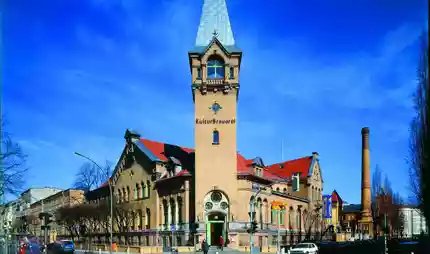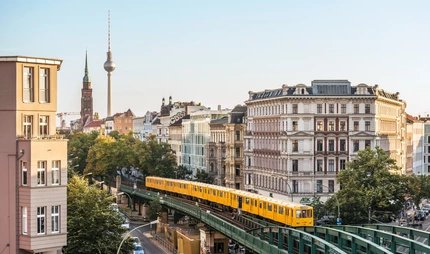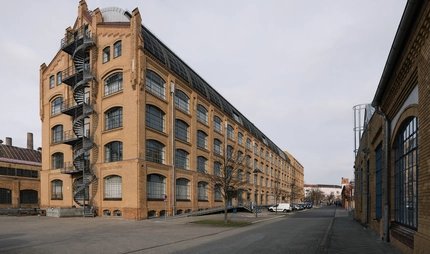
Stadtbad Oderberger Straße
Hygiene for everyone
At the beginning of the 20th century, swimming pools were not just for swimming. Visitors went to wash and shower.
Bathrooms were a luxury in times of the German Empire. In 1910, only ten percent of Berliners were able to shower or bath in their own homes, which was not only a lack of comfort, but also a danger to hygiene.
Ludwig Hoffmann, head of the municipal planning and building control office of Berlin, provided an answer to the rapidly growing population of the imperial capital with the construction of four municipal baths. Between 1899 and 1902, one of them was built in Oderberger Straße in Prenzlauer Berg.
Hoffmann's design was characterised by a rational organisation of the building. Right behind the entrance area, bathers would find cash desk and waiting areas for washing facilities on both sides. Separate stairwells led to the ladies' and men's changing rooms. The 63 showers and bathtubs were located in the side wings. Here, too, Hoffmann paid attention to state-of-the-art technology: the partition walls between the washing cubicles ended three centimetres above the floor – this facilitated ventilation and cleaning.
The largest part of the municipal baths was taken up by the indoor swimming pool, extending over three floors. Here, too, the building was well thought-out: instead of skylights, highlights on the side walls ensured pleasant lighting. The roof construction also prevented moisture on the ceiling.
The swimming pool itself, on the other hand, still reveals to this day that swimming in the municipal baths was only one possibility besides bathing and showering: measuring just 20 by 12 metres, not a great many visitors can be active in the pool at the same time.
Functionality in a wasteful outer shell
The fact that the Prenzlauer Berg municipal baths are purposefully designed only becomes apparent to the observer at second glance, as numerous decorative elements take attention away from this. Ludwig Hoffmann, who chose an Italian Renaissance façade for the Kreuzberg municipal baths, lent the building on Oderberger Strasse the appearance of a German Renaissance palace. High saddle roofs and roof superstructures with gables reinforce this historic design approach.
The Renaissance-style entrance is also reminiscent of historic town hall portals. Only a relief above the portal points out the actual significance of the building: water nixies bathing a bear.
The historicist stylistic elements are also continued inside. Here Hoffmann opted for a church look: a vault arches over the three-storey indoor swimming pool, while galleries and arcades adorn the sides of the hall. Arched windows frame the highlights and heighten the sacred feel.
The sculptor Otto Lessing provided both the façade and the interior spaces with numerous sculptures dedicated to the theme of water.
"Yes, yes, Hoffmann, we have all done him a disservice!"1 This is what the architect Ludwig Mies van der Rohe is alleged to have said about Ludwig Hoffmann in 1956, who at that time had almost been forgotten.
For 28 years – from 1896 to 1924 – Hoffmann was head of the municipal planning and building control office of Berlin and oversaw the construction of a total of 300 public buildings during this time. Among the most famous are the Märkisches Museum and the Virchow Hospital. But the young Modernist architects did not hold Hoffmann in high regard. They criticised his traditionalist style and were relieved when Martin Wagner, a progressive urban planner, became the head of the office in 1926.
Hoffmann's construction survived the Second World War. The roof and windows were broken, but the building was spared any worse damage. In the GDR, swimmers used the indoor swimming pool once more. However, in 1986 cracks in the pool became noticeable and the authorities closed the municipal baths.
The bathing facility on Oderberger Straße had been closed for three decades. Only in 2016 did this change. Private operators renovated the indoor swimming pool in line with its listed status and today run the building as Hotel Oderberger. The Berlin Landesdenkmalamt (State Monument Office) awarded them the Ferdinand-von-Quast Medal 2017.
Our tips for nearby the Prenzlauer Berg municipal baths
The Prenzlauer Berg municipal baths are open to external visitors. The opening hours can be found on the website of the Hotel Oderberger. Not far away are the extensive grounds of the Kulturbrauerei, the former Schultheiss brewery, with six courtyards and more than 20 buildings, which have been listed since 1974. This impressive industrial architectural monument with a red brick façade was built at the end of the 19th century and today houses among other things a cinema, restaurants, clubs, a theatre and a museum.
Practical information from visitBerlin
The Prenzlauer Berg municipal baths can be reached by taking U-Bahn line 2 to the Eberswalder Straße stop. To explore the city, we recommend the Berlin WelcomeCard for public transport.



